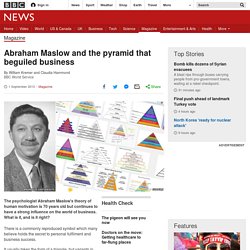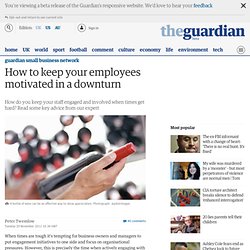

Abraham Maslow and the pyramid that beguiled business. The psychologist Abraham Maslow's theory of human motivation is 70 years old but continues to have a strong influence on the world of business.

What is it, and is it right? There is a commonly reproduced symbol which many believe holds the secret to personal fulfilment and business success. It usually takes the form of a triangle, but variants in the shape of 3D pyramids and staircases are not uncommon. It regularly appears in university psychology modules, and may pop up in other degree courses too. On management training courses it's as inevitable as biscuits and role-playing. In 1943, the US psychologist Abraham Maslow published a paper called A Theory of Human Motivation, in which he said that people had five sets of needs, which come in a particular order. First, we have the basic needs for bodily functioning - fulfilled by eating, drinking and going to the toilet. The next stage is all about social recognition, status and respect. But critics point to dozens of counter-examples. What makes us satisfied with our jobs? How to keep your employees motivated in a downturn.
When times are tough it's tempting for business owners and managers to put engagement initiatives to one side and focus on organisational pressures.

However, this is precisely the time when actively engaging with your employees is most critical as they will be scrutinising and judging leadership behaviour even more closely. There is plentiful research to highlight the positive correlation between engaged employees and increased performance. The flipside being that companies with a less engaged workforce experience higher staff turnover, greater absence levels, more internal disruption and less discretionary effort, all of which inevitably impacts on the bottom line. The key is to create an environment where employees genuinely feel engaged and involved, where there is a sense of collective responsibility and employees believe they have a degree of control over their destiny. • To be effective, communication should be comprehensive, credible and two-way.
. • Be visible. How do you improve team morale? Daniel Pink on the surprising science of motivation. Why You (And Your Employees) Have To Work. “Whenever it is possible, a boy should choose some occupation which he should do even if he did not need the money.”

William Lyon Phelps, American Author Growing up, I dreamed that one day I could say, “I don’t have to work.” My parents were both government employees of modest means who understandably viewed my lofty aspirations as an unlikely fantasy. My father passed away when I was in my mid-30’s, before he had a chance to enjoy the fruits of his lifelong labor. His premature death further solidified my desire to retire early. After an exhausting and exhilarating 13-years as a senior startup executive, I looked back on my career with satisfaction, having helped several companies create significant wealth, including: Computer Motion: IPO and later sold to Intuitive Surgical $148 million Expertcity: creator of GoToMyPC and GoToMeeting, sold to Citrix for $236 million CallWave: IPO, initial market cap ~$200 million At the age of 43, I decided that I would retire.
Finishing The Sentence.